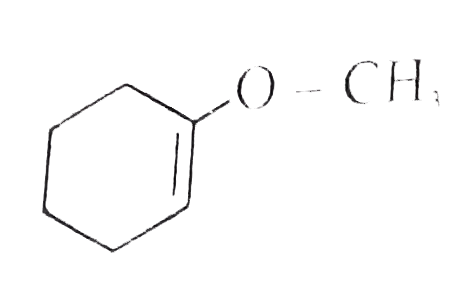Electrophilic addition reactions proceed in two steps. The first step involves the addition of an electrophile. Name the type of intermediate formed in the first step of the following addition reaction.
H3C−HC=CH2+H+→? Solution in Malayalam
2∘ carbanion
1∘ carbocation
2∘ carbocation
1∘ carbanion
The correct Answer is:C
H3C−HC=CH2+H+→H3C−HC+2∘carbocation(more stable)−CH3+CH3CH2CH+21∘carbocation(less stable)
Topper's Solved these Questions
- ORGANIC CHEMISTRY : SOME BASIC PRINCIPLES - PART II (ISOMERISM AND REACTION MECHANISM) BOOK - BRILLIANT PUBLICATIONCHAPTER - ORGANIC CHEMISTRY : SOME BASIC PRINCIPLES - PART II (ISOMERISM AND REACTION MECHANISM) EXERCISE - LEVEL-II
40 Videos
- ORGANIC CHEMISTRY : SOME BASIC PRINCIPLES - PART II (ISOMERISM AND REACTION MECHANISM) BOOK - BRILLIANT PUBLICATIONCHAPTER - ORGANIC CHEMISTRY : SOME BASIC PRINCIPLES - PART II (ISOMERISM AND REACTION MECHANISM) EXERCISE - LEVEL-II (ASSERTION-REASON TYPE)
20 Videos
- ORGANIC CHEMISTRY : SOME BASIC PRINCIPLES - PART I (NOMENCLATURE) BOOK - BRILLIANT PUBLICATIONCHAPTER - ORGANIC CHEMISTRY : SOME BASIC PRINCIPLES - PART I (NOMENCLATURE) EXERCISE - LEVEL-III
45 Videos
- ORGANIC CHEMISTRY : SOME BASIC PRINCIPLES - PART III (PURIFICATION AND CHARACTERISATION OF ORGANIC COMPOUNDS) BOOK - BRILLIANT PUBLICATIONCHAPTER - ORGANIC CHEMISTRY : SOME BASIC PRINCIPLES - PART III (PURIFICATION AND CHARACTERISATION OF ORGANIC COMPOUNDS) EXERCISE - LEVEL-II (ASSERTION-REASON TYPE)
15 Videos
Similar Questions
In the following compounds, nucleophile and the leaving groups are in the same molecule:

These dual nature species can undergo intramolecular and intermolecular nucleophilic substitution. Intramolecular substitution reaction is possible in: I, II; II, III; III, IV; IV
View SolutionAssertion : Simple carbanions are usually pyramidal but allyl carbanion is a planar species.
Reason : All the carbon atoms in allyl carbanion are sp2-hybridized.
View SolutionGive the IUPAC name of the following compound:

View SolutionAssertion : Sulphur present in an organic compound can be estimated quantitatively by Carius method.
Resaon : Sulphur is separated easily from other atoms in the molecule and gets precipitated as light yellow solid.
View SolutionAlkenes undergo electrophilic addition reactions. Electrophilic addition to unsymmetrical alkenes involve the formation of a more stable carbocation intermediate in the first step which is rate determining and carbocation is then attacked by a nuclephile to form product
 +H2OH2SO4−−−→ Product
+H2OH2SO4−−−→ Product
View SolutionElectrophillic addition reaction proceed in two steps. The first step involves the addition of an electrophile. Name the type of intermediate formed in the first step of the following addition reaction.
H2C−HC=CH2+H+→ ?
View SolutionElectrophilic additions reactions proceed in two steps. The first step involves the additions of an electrophile. Name the type of intermediate formed in the first step of the following addition reaction H_(3)C - HC = CH_(2) + H^(+) rarr ?
View SolutionElectrophilic additions reactions proceed in two steps. The first step involves the additions of an electrophile. Name the type of intermediate formed in the first step of the following addition reaction H3C−HC=CH2+H+→?
View SolutionElectrophilic addition reactions proceed in two steps. The first step involves the addition of an electrophile. Name the type of intermediate formed in the first step of the following addition reaction. H_(3)C -HC=CH_(2)+ H^(+)to ?
View SolutionAssertion (A): addition of HCN in alkene is a type of electrophilic substitution reaction. Reason (R) : in first step , H_(3)O^(+) attacks on double bond .
View SolutionElectrophilic addition reactions proceed in two steps. The first step involves the addition of an electrophile. Name the type of intermediate reaction. H_(3)C-HC=CH_(2)+H^(+)to?
View SolutionElectrophilic additions reactions proceed in two steps. The first step involves the additions of an electrophile. Name the type of intermediate formed in the first step of the following addition reaction H_(3)C - HC = CH_(2) + H^(+) rarr ?
View SolutionElectrophilic addition reactions proceed in two steps. The first step involves the addition of an electrophile. Name the type of intermediate formed in the first step of the following addition reaction.
H3C−HC=CH2+H+→?
View SolutionElectrophilic addition reactions proceed in two steps. The first step involves the addition of an electrophile. Name of type of intermediate formed in the first step of the following addition reaction . CH_(3)-CH= CH_(2) + H^(+) rarr ?
View SolutionElectrophilic addition reactions proceed in two steps. The first step involves the addition of an electrophile. Name of type of intermediate formed in the first step of the following addition reaction . CH_(3)-CH= CH_(2) + H^(+) rarr ?
View SolutionThe addition of HCl to an alkene proceeds in two steps. The first step is the attack of H+ ion to
 portion which can be shown as……..
portion which can be shown as……..
View Solution
